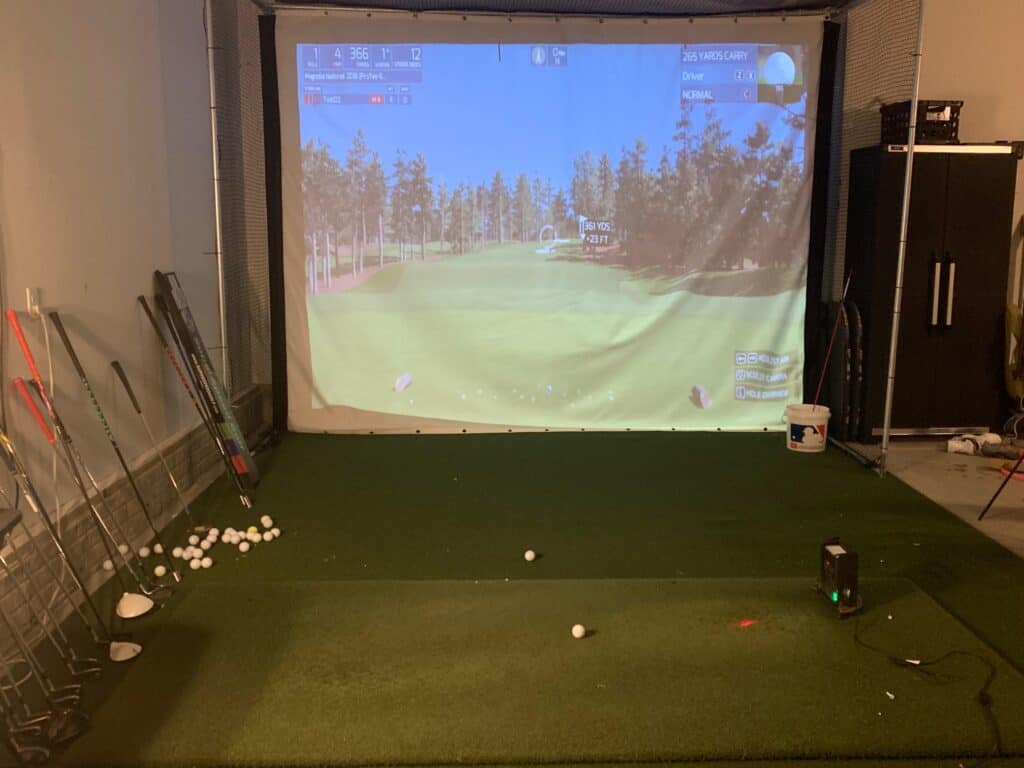It has happened to most of us!
We are playing our round and hitting our driver fine, when all of a sudden we push a driver way right and end up out of bounds, in a hazard and have to take a penalty drop, or lose a golf ball deep in the trees.
There are also the golfers that no matter what they do, they continuously push the driver to the right. Golf can be a frustrating game, but it doesn’t have to be!
What causes these shots and what can you do to fix this issue?
Let’s jump right in!
Why Am I Pushing My Driver Right?
The driver shot that starts right and stays right often will have a clubface that is 5-10 degree open at impact with a swing path that is also in the 5-10 degree path to the right. The clubface is actually somewhat squared to the swing path, resulting in the shot that starts right and stays out there.
This can be caused by a number of issues, which we will review below and help you with some causes, but first it is important to understand the ball flight laws and what causes different ball flights.
When you can have an idea on the ball flight laws, you have a better chance of making corrections during rounds or after rounds, simply from reading your ball flight.
Ball flight laws until the past decade or so were misunderstood. To understand the why behind the pushed right driver, let’s dive into the ball flight laws. Having a basic understanding will help you make the corrections by reading your ball flight during your practice sessions and even during your round of golf.

Overview of the Ball Flight Laws (With Examples)
Too often golfers turn to the video of their swing when everything you need to know can be read off of your ball flight. Did you know that your ball flight can tell you the following:
- Where your club face was at impact.
- If your swing path was left or right of the club face.
So let’s dive into the ball flight laws:
- Generally speaking, the golf ball will start where the club face is aiming.
- The golf ball will then curve away from the swing path.
There are two different lines that we must understand. The target line and the start line. The best golfers start the ball left or right of the target line and then curve the ball back towards the target.
Let’s go over some examples to help you better understand the ball flight laws.
Example A: Let’s say that the club face is 3 degrees right of the target line and the swing path is 5 degrees right of the target line. What will the ball do?
Answer: The ball will start right of the target line and draw back towards the target. This is known as a push draw.
Example B: Let’s say the club face is 3 degrees right of the target line, same as in example A, but the swing path is only 1 degree right of the target line. What will the ball do?
Answer: The ball will start to the right of the target line and will fade to the right. Keep in mind that the ball will curve away from the swing path. In this example, both the club face and the swing path are to the right and the ball will curve away from the path.
Example C: Let’s say the club face is 3 degrees to the left of the target line and the swing path is 5 degrees left of the target line. What will the ball do?
Answer: The ball will start to the left and curve to the right. This would be a pull fade or pull slice. Keep in mind that even though the face is closed to the target line, it is open to the swing path and the ball will curve away from the swing path.
Example D: Let’s say the club face is 3 degrees to the left and the swing path is only 1 degree to the left. What will the ball do?
Answer: The ball will start left and curve left. This shot would look like a pull draw.
Hopefully, these examples help you understand the club face and swing path correlation and how they match up. Once you understand these ball flight laws, it will help you read your own shots and possibly make in round adjustments.

Potential Cause #1: Sliding Hips
The push shot is a result of a swing path and a clubface that are too far right. The swing fault that most commonly causes this is an overactive hip slide towards the target. This can cause the swing path to move more to the right and if you aren’t closing the clubface with your hands, we can suffer from the shot that is blocked to the right.
While most swings have some element of sliding hips, too much hip slide causes the swing path to drop inside too much. At some point, the hips must start to turn which causes the swing path to go more left. This is similar to turning the corner. The hips must turn to bring the swing path left.
Potential Cause #2: Too far behind the ball
This is a swing fault of the more advanced golfer. They have trained themselves to stay behind the ball and to hit a push draw. At times, this can become too much of a good thing, resulting in a big push to the right or an overdraw. This is caused when the swing path drops too far inside and the golfer has to rely on the hands to time it up.
The pushed shot to the right with the driver can be a result of fear of the miss to the left and the golfer stays too far back and doesn’t release the club which usually helps the shot become a push draw for a push shot that stays to the right.

Quick Note: Timing
Many of the better golfers will get away with a significant out to in swing as they time it up with their hands at impact. There are those random shots or random days when the timing is off and this is when the golfer will struggle. Working on bringing everything more towards neutral will help the golfer find the consistency that we all strive for.
Solution: Bring Your Path and Face closer to 1-4 degrees
The goal shouldn’t be to zero everything out and try to hit the perfectly straight shot. We believe the stock shot is a pattern golfers should strive for. This is typically a push draw or a push fade. With the push draw the numbers around a 2-4 degree swing path with a club face that is 1-3 degrees to the right. This will result in a push draw.
The other option is a push fade, where the golfer aims slight left of the target. The golfer then stays to the inside with a swing path of 1-2 degrees right and a clubface that is 2-4 degrees open. This will start the ball slightly right and then fade towards the target.

Fix #1: Control Your Club Face
The first thing we must get under control is the clubface. Too open of a club face is not a good thing. We have to bring the clubface into that 1-4 degree open range.
Fix #2: Reduce the severity of your Swing Path
We also have to reduce the severity of the swing path and bring it more towards that 1-4 range as well.
How do you do this?
Drill: Stock Shot Drill
We want to develop a reliable shot shape. Here is a drill I would highly recommend:
- Set up an alignment stick about 7 to 10 yards in front of you on the target line.
- Set up a 2nd alignment stick about 3-4 feet right of the 1st alignment stick.
- See how many shots out of 10 you can start in this gate.
- Track this data over time and continue to work on your start line.
The goal for many golfers is to build consistency in the golf swing. Consistency is rooted in being able to control your low point, your start point and your curve of the ball.
The Stack and Tilt Instructors said it best when they described what they believed were the fundamentals of golf. They explained it somewhat similar to this:
- The first fundamental is the golfer’s ability to control the bottom of the golf swing. The best golfers will hit the ground in the intended spot, close to 100% of the time.
- The second fundamental is the golfer’s ability to control the curve of the golf ball. The best golfers are able to start the ball to the right or left of the target line and have the ball curve towards the target without the ball over curving past the target.
- The third fundamental is the golfer’s ability to have enough power to play the golf course. This means they are able to hit the ball far enough to play the course in regulation.

How To Measure Your Golf Swing
It can be helpful to know your swing path and club face direction at impact. In today’s golf world, even amateurs can have access to this technology and data with the technology now available.
The professional golfers of today all have access to some great technology including launch monitors to help measure their swing and know their numbers. Can an amateur use this same or similar technology for game improvement? Yes, absolutely and I would highly recommend it.
Even if you aren’t going to go all out and build an indoor golf simulator like I did (see below), you can still pick up a launch monitor at a reasonable price and use it in your indoor net or taking to the course or driving range with you!
Knowing numbers like spin rate, ball speed, spin axis and other key information is vital to your growth. Sharing these numbers with your instructor can be helpful and help with equipment selection as well.
I would recommend one of the three launch monitors listed below:
My Secret To Golf Improvement
Let’s face it, in order to get really good at golf, we must practice frequently. About three years ago, I made the leap and invested in a golf simulator build for my garage. I went with a SkyTrak Launch Monitor and the TGC software and can now play over 100,000 courses including Augusta, Pebble Beach, Bethpage Black, Whistling Straits. St. Andrews and many other of the top 100 courses in the world.
This golf simulator setup, which is more affordable that you might imagine, has been a game changer. I can now play golf everyday of the year regardless of rain, snow, cold weather or time of day. I can practice or play rounds of golf. I can stand in the 11th fairway at Augusta and with the auto-rewind feature I am able to practice my approach shots from various differences.
It is worth checking out through Rain or Shine Golf as they offer some incredible packages along with financing offers that are difficult to beat.
Some direct links to Rain or Shine Golf for pricing and financing:
Take Action – What You Can Do Today to Get Better
What does this mean for you? I believe in the following recipe to get better:
1 – Improve your motion in the golf swing by identifying a golf instructor. Here are some options:
Here is a list of golf instructors that we have reviewed:
2 – Train to swing faster and improve your swing speed. Here are some options:
Looking to gain more Speed and Distance in your swing. Two Options:
3 – Understand course strategy and work to break through your next barrier. Here is a series on breaking through:
We have provided guides on how to break 100, 90, 80 and 70. Check out more below, if interested.
4 – Practice Frequently
Did you know that I build a golf simulator in my garage and have played over 500 rounds of golf on my SkyTrak system? It has been a game changer and one worth checking out. Here are some of my other posts on golf simulators frequently asked questions:
- Is a Golf Simulator Worth It?
- How to Build a Golf Simulator?
- What is the Best Golf Simulator?
- Golf Simulator Accessories?
- How to Build a Golf Simulator for under $7000
- Top 11 Reasons to Buy a SkyTrak
- How to Build a Golf Simulator for Under $1000
- Why Build A Golf Simulator?
- What Space is Needed?
- Can A Golf Simulator Improve My Game?
- How Much Does A Golf Simulator Cost?
- Don’t Forget to Check out our 15 best golf swings of all time.
